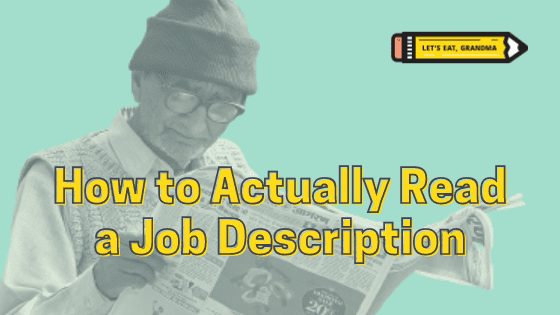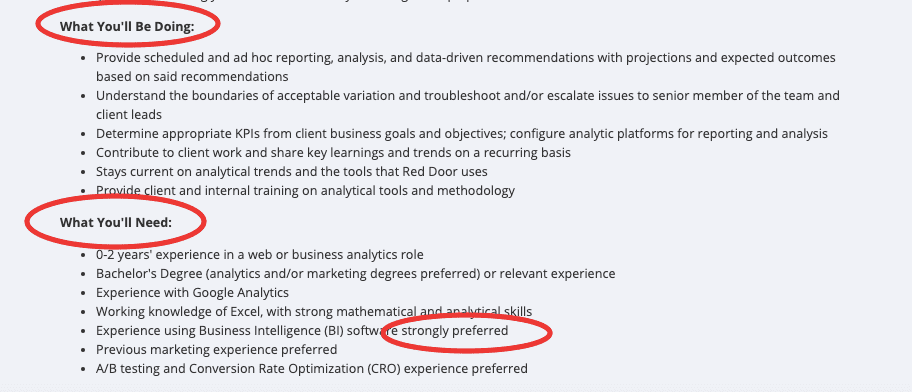How to (Actually) Read a Job Description

Tailoring your resume and cover letter to the needs of the job posting can land you an interview. Here’s a guide to deep reading a job posting to learn what they want.
Updated January 2024.
By: Jennifer Meehan | Contributor for Let’s Eat, Grandma
If you’re like me, when you see a job posting in your field with the job title you want, you might not take the time to really read the description at first. You could jump right into a cover letter before you notice the job requires 10 more years of experience than you have or proficiency with a computer program you’ve never even heard of.
In fact, one study showed that job seekers spend just around one minute reading a job posting.
But did you know that’s putting you at a disadvantage before you even apply?
Want more job search tips? Sign up for our newsletter!

Photo by Thought Catalog on Unsplash
Reading a job description thoroughly is arguably the best thing you can do to stand out from the other applicants.
This step is crucial for job seekers and will set you up for success with all elements of the job search process, from selecting the right positions to apply for, to performing well in interviews, and ultimately finding a role that is a good fit both professionally and personally.
In today’s competitive job market, understanding the nuances of a job listing goes beyond just skimming through the requirements. It’s about aligning your unique skills and experiences with the needs of your potential employer, and identifying opportunities where you can truly thrive. Whether you’re a seasoned professional or just stepping into the workforce, this post aims to shed light on why meticulously analyzing job descriptions is a key step in your job search journey, and how it can significantly increase your chances of not only landing an interview but also finding a role that fits like a glove.
Understand the job title
Your first step in reading a job description will be to research what the title typically entails in your industry. Don’t be fooled by the job title, however: The same title can mean vastly different things across industries and companies.
Once when I was job hunting I saw an ad for a managing editor for a journal. ”Great,” I thought, “I’ve been a managing editor at a financial company, where I edited and produced an investor magazine and several newsletters.” Right away I started pounding out a cover letter.
If I had read the description more carefully and done some research, I would have discovered that being a managing editor at that journal involved managing everything, including author relations, acquisitions, marketing, accounts receivable.
Often, if a title catches your eye you can move on pretty quickly to the rest of the post to decide if you’re qualified for the job or not.
Focus on the listed responsibilities
Most job postings follow the same basic structure: a description of the company, outline of duties, qualifications (both required and preferred), and a selection of personality traits the company is looking for.
This will give you a clear idea of what the job will entail on a day-to-day basis and help you decide if it aligns with your skills and interests.
Terms like self-starter, collaboration across diverse teams, good communications skills, detail-oriented, and people skills show up over and over again. You may be sick of looking at them, but just because they’re unoriginal doesn’t mean you can gloss over them.
If you prefer working with guidance and as part of a team, then perhaps you shouldn’t apply to a job that emphasizes “works well independently” or “requires minimal supervision.”
Make note of key qualifications
You also need to pay attention to the required and preferred qualifications. This includes education, skills, and experience. Be realistic about whether you meet these requirements.
As you’re reading a job description, highlight the skills it’s asking for. (You can even print and physically highlight it if you’re more analog than digital.) Hard skills like video production or reporting absolutely need to be mentioned on your resume. The so-called soft skills, like “detail-oriented”, “cross-functional leadership,” and “creativity” can be implied in your resume bullets, but they should also be heavily integrated into your cover letter.
In both cases, use keywords from the job posting. Have it nearby so you can refer to the qualifications you’ve highlighted while you’re crafting your resume and cover letter. This is not only important for Applicant Tracking Systems but also for the human decision-makers evaluating your resume. The hiring manager who wrote the ad will be pleased to see you’ve taken the time to really consider what they want. (And in many cases, if you don’t clearly include those required qualifications, a recruiter could be forced to disqualify your resume!)
Be realistic about your own qualifications, though. On one hand, if you only have a year’s experience in advertising, don’t waste your time applying for a senior position that specifies 10 or more years of experience.
On the other hand, if you have been a graphic designer for the past 5 years, don’t try to apply for an entry-level job as an office gofer for a design company; they’ll disregard your resume. Being overqualified can be just as bad as being underqualified.
One rule of thumb, according to some experts, is that if you meet at least 80% of the requirements, you should apply.
The experience conundrum
Most applicants looking for a job straight out of college have run into the same problem: “Requires at least 2 years’ experience” or “2-5 years of experience required.” If you’re looking for an entry-level job, of course you’re not going to have years of experience! That can be the most frustrating part of job hunting.
But before you throw up your hands in disgust, think carefully about what you’ve already accomplished — you’d be surprised at what counts towards your total of “relevant experience.” Sit down and make a list of your skills and projects, including coursework, internships, and volunteer work. Just because it wasn’t a paid, post-college job doesn’t mean it can’t translate into experience.
Perhaps you put together a database of early American folktales for an assistant professor writing her dissertation, which could apply to the history museum job you’re applying for. Or you could have written a marketing plan and shot some advertisements for a local store for your business school capstone project. And any internships count toward experience regardless of whether they were paid, of course.
For example, when I was a senior in college I had an internship with the university press. I learned about academic publishing and edited a manuscript. When I started looking for entry-level publishing jobs out of college I was able to include that under experience on my resume.
This applies if you’re changing careers after a few years of experience, too. Take note of whether the posting calls for years of “industry experience”, experience with the particular job title, or “relevant experience.” In most cases, you can emphasize how your past experience transfers into this new field. By showcasing your transferable skills in your resume bullets and cover letter stories, you can often prove that you’ve capably done the duties of this job without actually holding it yet.
By listing a requirement for a couple of years of experience, the hiring manager could be trying to screen for candidates who are serious about the job. But if you truly think this job is a good fit, you’ll be able to convey that with your relevant experiences. Just be sure to clearly explain how your skills transfer in your cover letter.

Photo by Mimi Thian on Unsplash
Big-picture research
Once you have read the job description thoroughly, established what the job is about, and determined it fits your interests, goals, and expertise, it’s time to dig a little deeper outside of the ad.
- Research the company: Go to the website and find out exactly what it does. What types of clients does it serve? Is it a humongous multinational or a more intimate small enterprise? Here also you will probably be able to see staff bios. Are the senior positions all filled by old white men or does it look more diverse? Learn about their mission and values too — have they been in the news or industry thought leadership recently? Once you’ve gotten the scoop, include what you know about the company in your cover letter to show initiative and how your values align with theirs.
- Clarify compensation: Unless you’re applying for an hourly position, job postings rarely state a salary. At best they’ll list a range. Once the HR department or hiring manager calls to set up an interview, you should ask straight up. While you’re applying, though, try looking up salaries in your field on Glassdoor. Ask mentors or your college career office for an idea. If the pay is simply too low to support you, it’s time to look elsewhere.
- Make a list of questions: While you’re reading through the job posting and doing follow-up research, make a list of questions you still have about the job and the company. Then prepare to ask them when the interviewer asks, “Do you have any questions for us?”
- Look for hints: A job description can tell you some things about the work environment just by the way it’s written. A breezy-sounding casual “we all love working here” vibe probably means it’s a younger, “hip” company culture. Or if the wording is strictly formal, that could indicate it’s best for more seasoned, serious-minded people. Also, words like “deadline-driven” and “works well under pressure” could be code for a job where you’re expected to do the work of two people.
- Get your stuff together: Finally, apply correctly. Make sure you upload all they have asked for in the correct format. Did they ask for a resume in a certain file format? Did you write a cover letter if they asked for one? How about a separate document for references? Don’t rush this step.
As you can see, reading a job description involves a lot more than glancing at the requirements.
Take some time to really read it through to create the best cover letter and resume for the job. Once you see how many more interviews you’re getting, you’ll be grateful you did.
Want more job search tips sent straight to your inbox? Sign up for our newsletter here:
Better Resume.
Satisfying Career.
Happier You.


